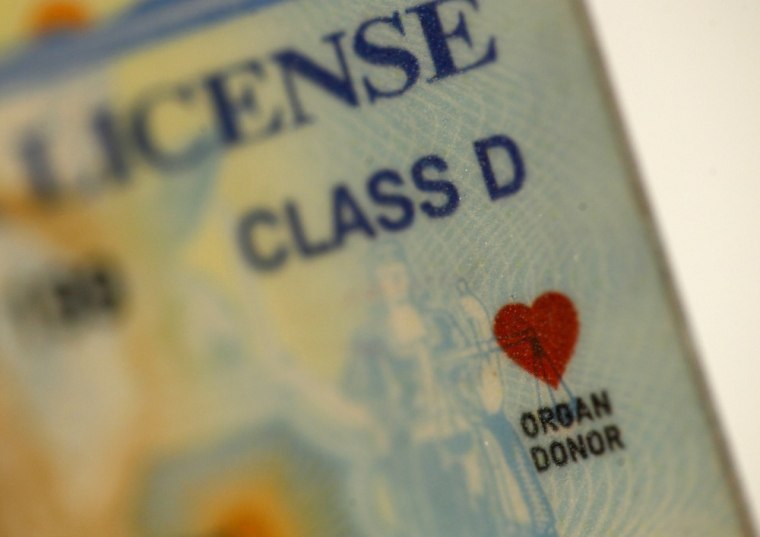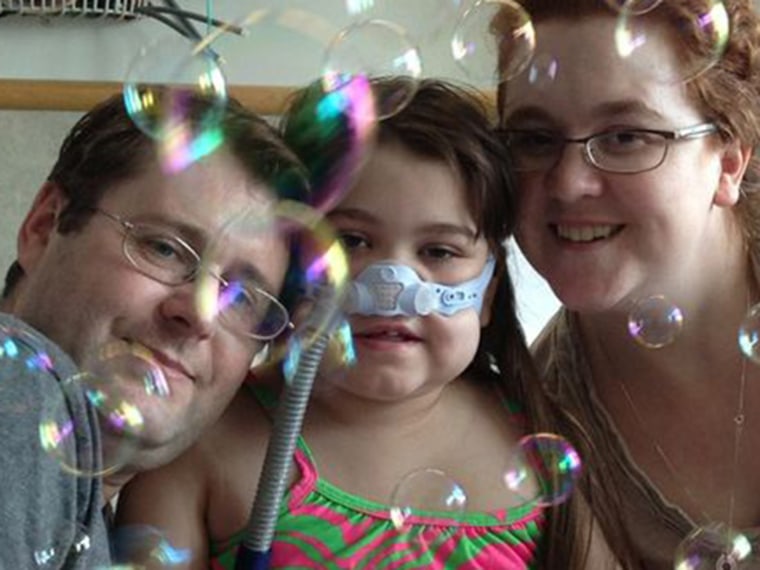As soon as word spread that little Sarah Murnaghan needed a lung transplant, the offers started rolling in.
Not from the families of deceased donors who might save the life of the 10-year-old Pennsylvania girl with cystic fibrosis, but from concerned strangers who saw or heard the child’s plight in national news stories and wanted to do something -- anything -- they could.
“I was looking at her picture and that just touched my heart and I got tears,” said Daniel Barr, 60, an ex-Marine from Cecil, Ark., who offered to volunteer his own lung for Sarah. “I just wanted to jump up and say, ‘Here, take it!’”
Hundreds of people shared Barr’s sentiment, even though the girl’s family said that she wasn’t suitable for a living lung donation. What many may not have shared is Barr’s longtime designation as an organ donor -- and not just for Sarah.
“I’ve been one just about forever,” said Barr, who lost his own daughter, Kelly Nichole, in 1991, and donated her heart and eyes. “I wish more people would. You could really cut the backlog of people waiting – and dying.”
Only about 45 percent of adults in the U.S. -- nearly 109 million people -- are organ donors, a figure that donation and transplant experts say seems tragically low when the public’s attention is riveted on the lack of organs for a child such as Sarah.
“We have millions of people that are concerned or outraged about this particular situation, yet 55 percent don’t sign up to donate,” said David Fleming, the president and chief executive of Donate Life America, a transplant advocacy agency that tracks U.S. donors.
The proportion of adults signed up as organ donors varies surprisingly widely across the U.S., from Montana, where 82 percent of people older than 18 are designated donors, to New York, where 20 percent are signed up. In Vermont, the figure is only 5 percent.
People typically sign up for organ donation when they acquire or renew driver’s licenses, and state motor vehicles departments keep track of the records. But it’s also possible to register online any time, driver’s license or no.
The biggest barrier to registering is procrastination -- tempered with a little denial, said Sharon Ross, a spokeswoman for the San Diego affiliate of Donate Life.
“I think we, as a nation, as a whole, don’t think about death or want to think about death,” she said. “Many of our deaths are unexpected and sudden and we just don’t take the time to sign up.”
But when a situation like Sarah Murnaghan's arises, it suddenly commands attention.
"It really puts a face on the need," said Fleming. "I have a 10-year-old daughter. If my 10-year-old daughter needed an organ, I would be doing anything in my power to save her life."
More than 118,000 people are waiting for organs, including nearly 76,000 who actively need them now, according to OPTN. About 18 people die every day awaiting transplants.
“People sometimes believe that organ allocation is the primary issue, when in reality, the crisis is the lack of supply of organs for transplant,” Fleming said.
Indeed, the focus for two weeks has been on the complicated two-tier system that governs the way children and adults receive organs. Created by the Organ Procurement and Transplantation Network, or OPTN, it limits kids younger than 12 to organs from other children of similar age and size and gives teens and adults first chance at adult organs – even if the youngest kids are sicker.
Transplant experts say the 2005 rule replaced a first-come, first-served system and cut waiting list deaths by 40 percent.
But Sarah’s parents challenged the rule, saying it denied their child the chance to compete for an adult organ based on the severity of her illness instead of her age.
They launched a massive PR campaign that garnered headlines, political backing and, on Wednesday, a judge’s rule ordering Health and Human Services Secretary Kathleen Sebelius to direct OPTN to put the child on the adult list.
By Thursday, another child awaiting a lung transplant, 11-year-old Javier Acosta, had been bumped up by the court as well.
Surgeons and ethicists objected to the move, saying it undermined a system designed to be impervious to individual cases and that it allowed non-doctors to make medical decisions.
“The whole point of having rules is to avoid special pleading,” said Art Caplan, director of the division of medical ethics at NYU Langone Medical Center and a frequent NBC News contributor.
Making exceptions to the system also reinforces a common suspicion that celebrities, the wealthy and people with the right ties have an inside track on organ transplant, Fleming said. "If it continues on this path, it is setting a dangerous precedent."
Donation advocates say there’s one certain way to avoid what Sebelius described as the “incredibly agonizing” situation of having to ration organs: Get people to donate.
“We certainly believe that if everyone were a registered donor, it could double the number of transplants each year,” said Fleming, noting it would boost last year’s 28,000 transplants to more than 56,000.

That wouldn’t erase the waiting list, but it would go a long way toward satisfying the need. Each person who agrees to donate organs can help as many as eight recipients, experts say.
No one knows for sure the size of the pool of potential donors, Fleming said. Organs are harvested from people who are brain dead, or in certain cases, whose hearts have stopped, but conditions from disease to the manner of death can render many potential transplants useless.
Less than 1 percent of the 2.5 million people who die each year in the U.S. may provide viable organs, experts say. That makes it even more crucial to encourage every possible registration, a task that has occupied transplant centers and donation advocate for decades.
They work hard to rebut common myths about organ donation designation, including this one: ER doctors won’t work as hard to revive potential donors in a crisis.
“We hear that all the time,” said Fleming. “I have friends who are registered donors who wink and say, ‘Will they really try to save me?’”
Minority groups including blacks, Hispanics and Asians are often reluctant to donate, primarily because of religious or cultural reservations, experts say. White people account for about two-thirds of all organ donations.
There are strong regional leanings as well. All across the rural West -- Alaska, Washington, Oregon, Montana -- organ donation designations are high, 74 percent or higher.
“There are some areas of the country that have a very strong sense of community and commitment to your neighbor,” Fleming said. “In some urban centers, you may not know your neighbor.”
OPTN executive members plan to meet Monday to consider the way pediatric lungs are allocated. The outcome may or may not help Sarah Murnaghan and other children like her, but organ experts say one thing will.
“The real message is this,” Fleming said. “If you feel discomfort or outrage for this young woman, the real response, the way to provide hope to people like Sarah is to become an organ donor.”
Related stories:
